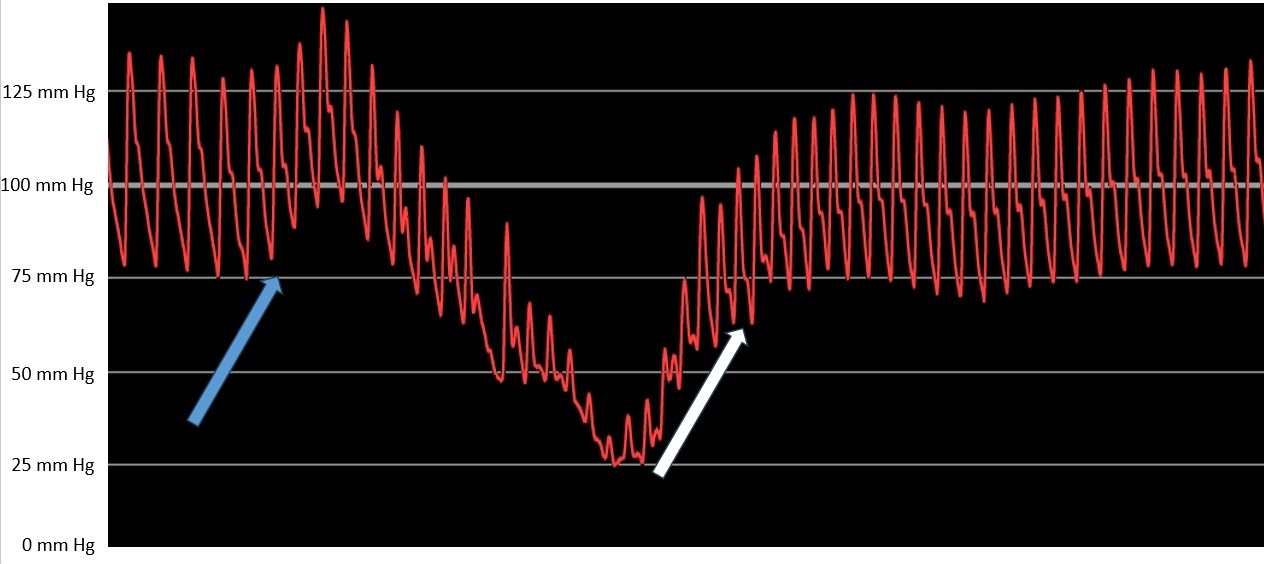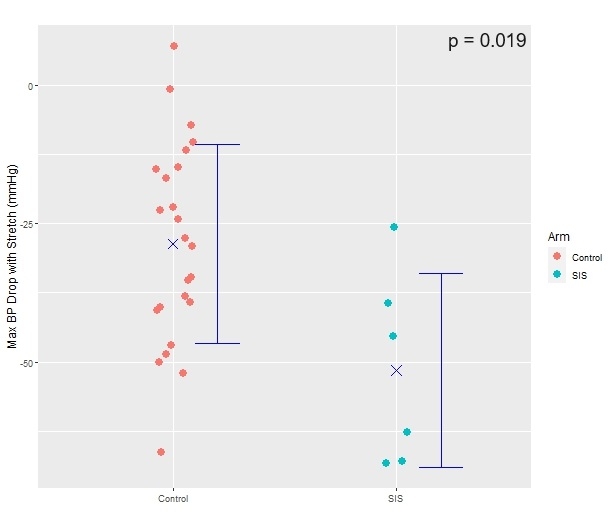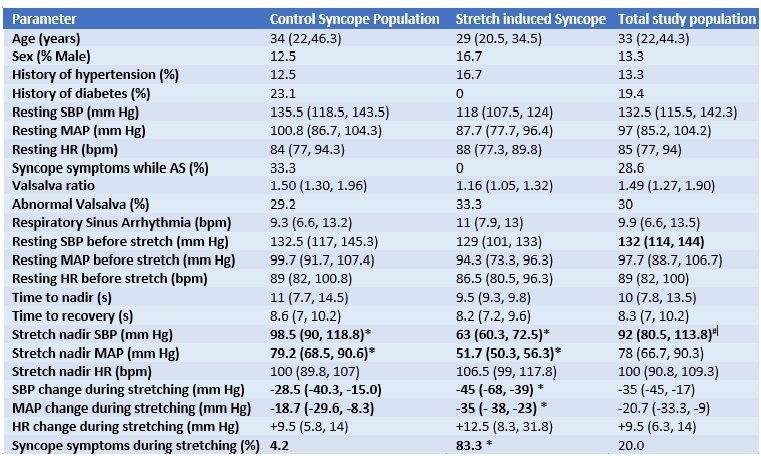Final ID: MDP1802
Systemic hypotension triggered by stretching of shoulder and upper back muscles: A possible basis for ‘stretch-syncope’ in humans
Abstract Body (Do not enter title and authors here): Background: Stretch induced syncope (SIS) is a well-known but rare condition of uncertain pathophysiology. Proposed but unproven mechanisms include Valsalva-like straining, transient vertebral artery occlusion, carotid baroreceptor activation or a combination of these. We hypothesized that shoulder and upper back stretching, possibly acting through skeletal muscle mechanoreceptors, may trigger a hypotensive response, similar to that induced by stretch of other large skeletal muscles (e.g., legs and forearms), but opposite in direction.
Objective: This study evaluated the impact of shoulder and upper back stretch on autonomic and hemodynamic findings in otherwise healthy patients with SIS by history compared to controls being evaluated for syncope or near syncope unrelated to stretch.
Methods: The study comprised 18 otherwise healthy patients presenting for hemodynamic and autonomic evaluation of syncope or near-syncope. None had evidence of underlying structural cardiovascular disease or abnormal neurological findings on exam.
Autonomic evaluation was performed in included i) heart rate (HR) and blood pressure (BP) responses during active standing (AS), ii) Valsalva maneuver, and iii) respiratory sinus arrhythmia. Suspected SIS patients also underwent carotid sinus massage while seated. In addition, seated patients were instructed to undertake active extension of the neck and shoulders for approximately 10 seconds while keeping their forearms still and breathing normally. HR and systolic and mean BPs were recorded using beat-by-beat non-invasive plethysmography.
Results: The patient population comprised 5/18 patients with a history suggesting SIS and 13/18 controls. With stretching, both SIS and control patients exhibited decreased systolic and mean arterial pressure (MAP), and increased HR. Further, SIS patients had a greater decrease in SBP and MAP during stretch than controls (p=0.021 and 0.029). Syncope or near-syncope developed in four SIS patients (80%) during stretch while no control experienced syncope or near-syncope (p<0.001).
Conclusion: Stretching of upper body musculature induces a previously unrecognized transient hypotensive response within humans. SIS patients manifesting more marked hypotension than controls. Thus, vasodepression, possibly initiated by stretch-induced mechanoreceptor activation within upper back and neck muscles, offers a basis for systemic hypotension in stretch-induced syncope.
Objective: This study evaluated the impact of shoulder and upper back stretch on autonomic and hemodynamic findings in otherwise healthy patients with SIS by history compared to controls being evaluated for syncope or near syncope unrelated to stretch.
Methods: The study comprised 18 otherwise healthy patients presenting for hemodynamic and autonomic evaluation of syncope or near-syncope. None had evidence of underlying structural cardiovascular disease or abnormal neurological findings on exam.
Autonomic evaluation was performed in included i) heart rate (HR) and blood pressure (BP) responses during active standing (AS), ii) Valsalva maneuver, and iii) respiratory sinus arrhythmia. Suspected SIS patients also underwent carotid sinus massage while seated. In addition, seated patients were instructed to undertake active extension of the neck and shoulders for approximately 10 seconds while keeping their forearms still and breathing normally. HR and systolic and mean BPs were recorded using beat-by-beat non-invasive plethysmography.
Results: The patient population comprised 5/18 patients with a history suggesting SIS and 13/18 controls. With stretching, both SIS and control patients exhibited decreased systolic and mean arterial pressure (MAP), and increased HR. Further, SIS patients had a greater decrease in SBP and MAP during stretch than controls (p=0.021 and 0.029). Syncope or near-syncope developed in four SIS patients (80%) during stretch while no control experienced syncope or near-syncope (p<0.001).
Conclusion: Stretching of upper body musculature induces a previously unrecognized transient hypotensive response within humans. SIS patients manifesting more marked hypotension than controls. Thus, vasodepression, possibly initiated by stretch-induced mechanoreceptor activation within upper back and neck muscles, offers a basis for systemic hypotension in stretch-induced syncope.
More abstracts on this topic:
A Bifunctional Actuator Reverses NaV1.5 Dysfunction Linked To Cardiac Arrhythmias
Fossier Lucile, Yehya Marc, Mahling Ryan, Gabelli Sandra, Colecraft Henry, Ben Johny Manu
Derivations of Supine and Standing Blood Pressure and Their Associations with Adverse Cardiovascular and Hypotension-Related EventsMate-kole Manfred, Lutsey Pamela, Juraschek Stephen, Turkson-ocran Ruth-alma, Larbi Fredrick, Col Hannah, Khan Md Marufuzzaman, Ngo Long, Wagenknecht Lynne, Windham B Gwen, Selvin Elizabeth



